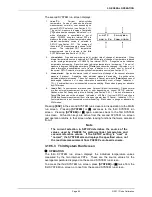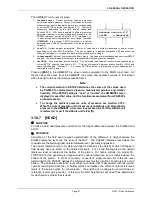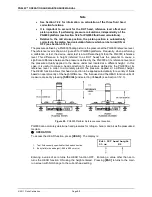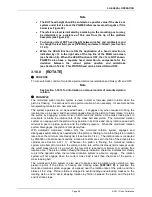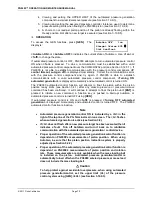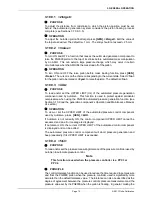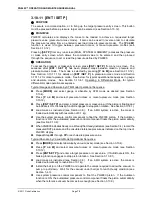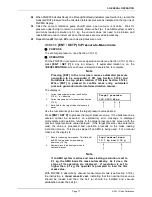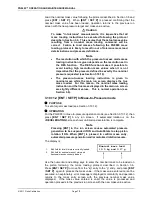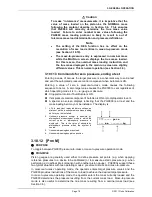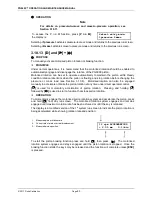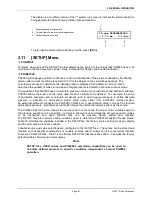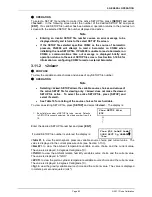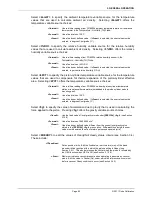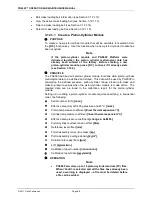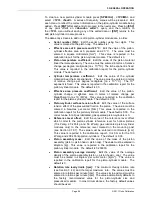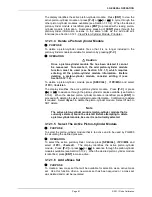
Page 79
© 2011 Fluke Calibration
Caution
To make “in tolerance” measurements, it is imperative that the
value of mass loaded on the piston be the NOMINAL mass
following the protocol describe in Section 3.6. This ensures
that PG9000 will correctly determine the true mass value
loaded. Failure to enter nominal mass values following the
PG9000 mass loading protocol is likely to result in out of
tolerance mass load determination and pressure definitions.
Note
•
The setting of the RES function has no effect on the
resolution of mass load entries in mass-to-pressure mode
(see Section 3.10.10).
•
The mass-to-pressure entry is expressed in nominal mass
while the MAIN run screen displays the true mass loaded.
For this reason, the nominal mass loading instruction and
the true mass displayed in the main run screen are slightly
different values. This is normal operation (see Section 3.6).
3.10.11.3 Commands for zero pressure, ending a test
Entering a value of zero as the target pressure is a convenient way to end a test
and vent the automated pressure control component when AutoGen is ON.
Entering a value of zero in
pressure-to-mass
mode causes the following
sequence to occur. A zero target value causes the PG9000 to vent regardless of
which operating mode it is in – ie: gauge or absolute.
Stop piston rotation if AutoRotate is ON.
Vent pressure control component if AutoGen is ON or prompt operator to vent.
A special run screen displays reflecting that the PG9000 is at rest and the
mass loading bell may not be installed. The display is:
1.
<?>
in ready/not ready indicator positions as
status of piston is unknown since mass loading
bell may not be installed.
2.
Unknown pressure except in absolute by
atmosphere measurement mode in which the
current value of atmospheric pressure is
displayed. This is the value of absolute by
atmospheric pressure when the system is
vented.
3.
Unknown/meaningless mass load.
4.
Unknown/meaningless piston position.
???----- psi a
--- mm --------kg
3.10.12 [P
OR
M]
PURPOSE
To toggle between PG9000
pressure-to-mass
or
mass-to-pressure
operation mode.
PRINCIPLE
Piston gauges are generally used either to define pressure set points (e.g. when applying
reference pressures to a device to be calibrated) or to measure a static pressure (e.g. when
performing a crossfloat intercomparison with another piston gauge). PG9000s support these
two typical situations with two operating modes:
pressure-to-mass
and
mass-to-pressure.
In
pressure-to-mass
operating mode, the operator enters target pressure values and the
PG9000 provides instructions of the mass to load to achieve the desired target pressure.
In
mass-to-pressure
operating mode, the operator enters the mass currently loaded and the
PG9000 determines the pressure resulting from the current mass load.
Mass-to-pressure
mode
is also useful to determine the true mass resulting from a nominal mass load (see
Section 3.6).
Содержание PG9000 Series
Страница 10: ...PG9602 OPERATION AND MAINTENANCE MANUAL 2011 Fluke Calibration Page X Notes...
Страница 128: ...PG9602 OPERATION AND MAINTENANCE MANUAL 2011 Fluke Calibration Page 118 Notes...
Страница 164: ...PG9602 OPERATION AND MAINTENANCE MANUAL 2011 Fluke Calibration Page 154 Notes...
Страница 188: ...PG9602 OPERATION AND MAINTENANCE MANUAL 2011 Fluke Calibration Page 178 Notes...
Страница 192: ...PG9602 OPERATION AND MAINTENANCE MANUAL 2011 Fluke Calibration Page 182 Notes...

